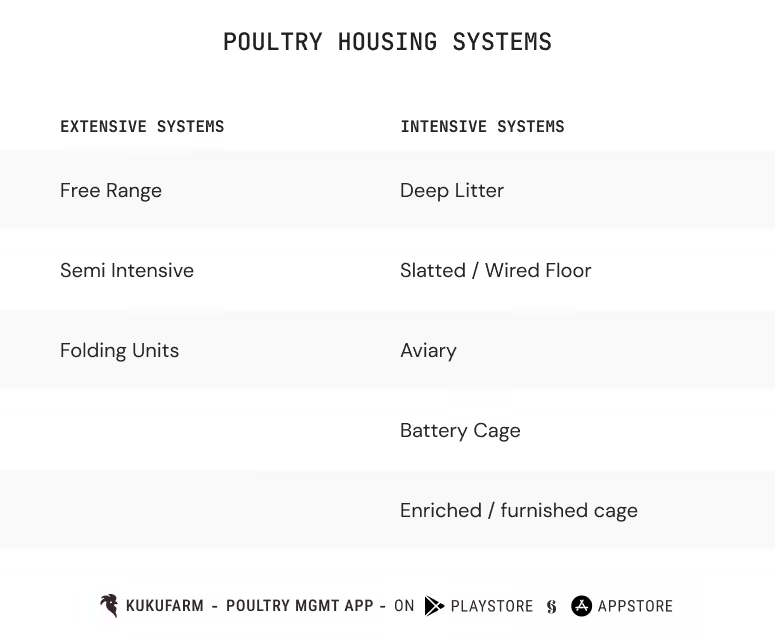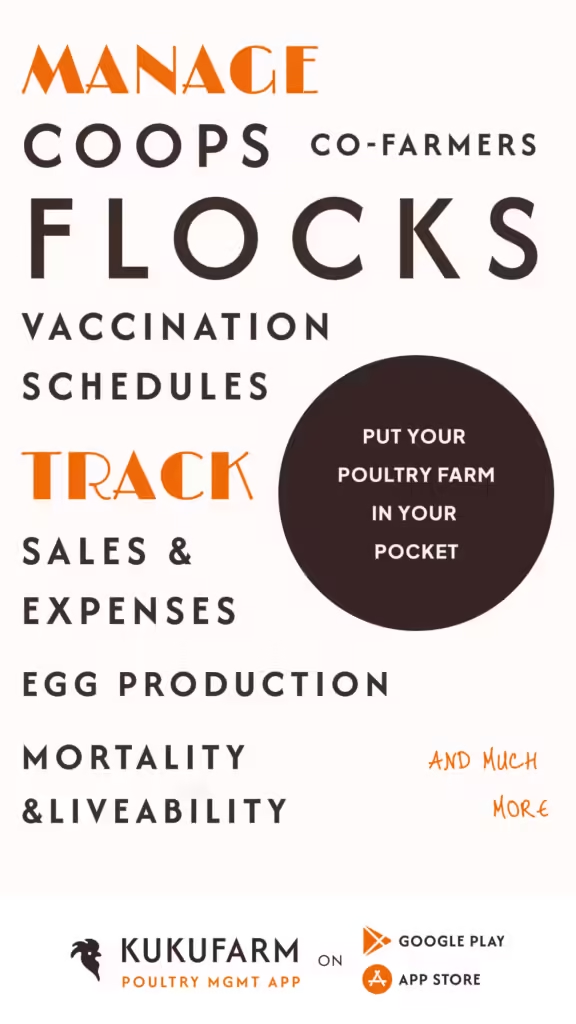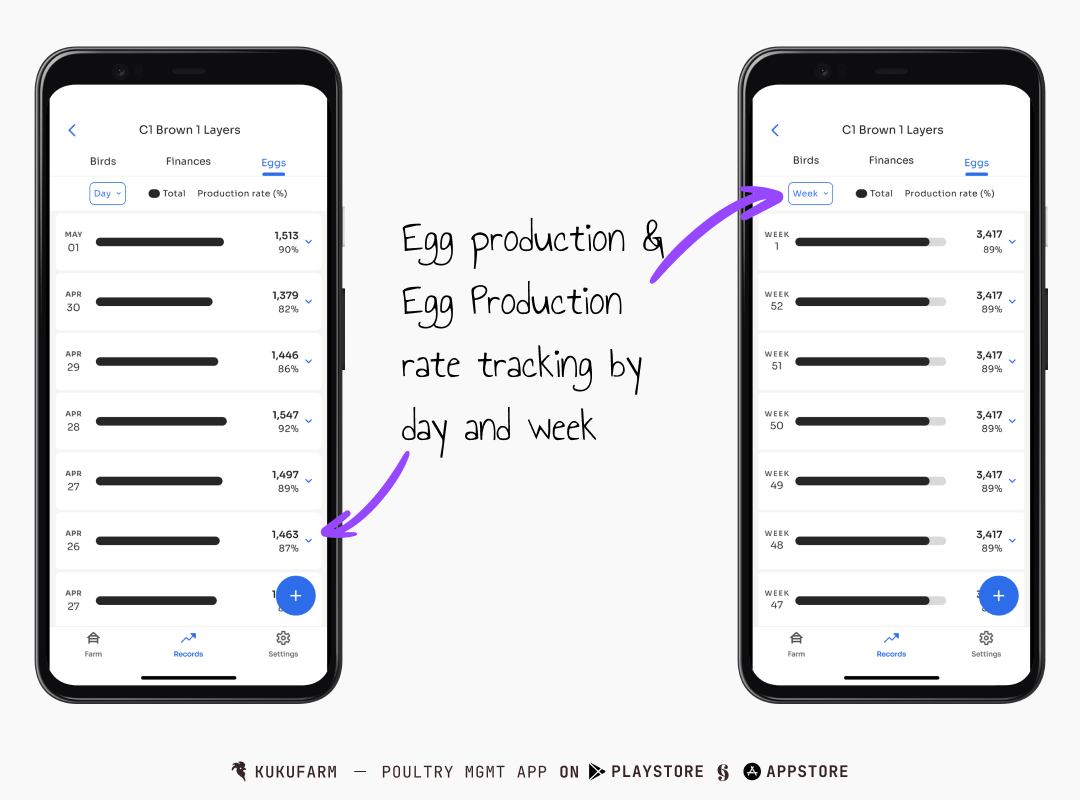In this article we do an overview of poultry terms and definitions. Specifically, we describe words commonly used in, or applicable to poultry farming.
Some key poultry terms
- Flock schedule
- Poultry system / poultry housing system
- Flock mortality & liveability
- Coop
- Flock
Essentially, understanding poultry terms and definitions should make you knowledgeable in the domain of poultry farming and even more so in using poultry apps.
For instance, Kukufarm poultry management app uses terms such as poultry system, coop, flock, mortality and egg production rate.
Poultry terms and definitions
Below we present some key poultry terms and definitions. We believe that understanding these terms will help you in poultry record keeping, and poultry farming in general.
Poultry
The word poultry refers to any kind of birds that are domesticated. Contrary to popular belief, poultry does not refer to chicken only. It refers to a wide variety of birds that you can raise.

Example of poultry birds include – chicken, emu, duck, geese, ducks, ostriches, turkey, pigeons, parrots, just to mention a few.
Coop
Simply put, a coop is a chicken house. It is the structure in which you keep your poultry birds.

Poultry system / Poultry housing system
Poultry system or poultry housing system refers to the type of system or housing applied to a coop. In total, there are 8 poultry systems. These are free range, semi intensive, folding units, deep litter, aviary, slatted floor, cage, and enriched cage.

Moreover, poultry housing systems are grouped under two main categories: extensive and intensive poultry systems.
Flock
A flock is a group of poultry birds that are housed together. Usually, in commercial farming settings, a flock is a group of birds of the same age, that are housed together in the same coop.
Additionally, a flock also refers to a group of birds of the same age and purpose, that are housed together. Thus your layers flock will usually consist of a group of birds raised for egg production. Moreover, your broilers flock consists of a group of birds of the same age raised purposely for meat production.

However, if you’re a backyard poultry farmer, a flock can refer to a group of birds of different ages, and multi-purpose birds that are housed together. For example, your flock may comprise of hens, roosters, and young chicken, raised for both meat and egg production.
Moreover, if you’re an ornamental poultry farmer, a flock can refer to small group of birds that you raise for show and exhibition.
Flock mortality and mortality rate
There term flock mortality refers to the number of birds that die before your flock reaches maturity. Furthermore, flock mortality is usually expressed in percentage. For example, if in your flock of 100 birds, 2 die before maturity, your flock has a mortality rate of 2%.

As a poultry farmer, flock mortality rate is an important flock performance indicator. When selecting a breed or strain of poultry birds, you should pick one that has the least mortality rate.
Kukufarm poultry app enables you to track flock mortality and flock mortality rate. In addition, having such data enables you to compare your flock performance against supplier benchmarks, or other farmers.
Flock liveability and liveability rate
Flock liveability refers to the number of birds in a flock that reach maturity, and live till flock harvesting. Similarly to flock mortality, flock liveability is best expressed in percentage. For instance if in a flock of 100 birds, 98 live to maturity, that flock has a liveability rate of 98%.
Flock mortality and liveability rate is one of the 5 key indicators of flock performance. The rest are egg production rate, feed conversion ratio, weight and financial yield.
Livestock
Livestock refers to the number of live birds in your flock at any given time.
Flock schedule
A flock schedule is a timetable that outlines different flock management activities over a flock’s lifetime. Said timetable includes activities such as feeding, vaccinations, weight monitoring, egg production cycle and so on.
Fundamentally, a flock schedule helps a poultry farmer anticipate and plan poultry farm and flock management activities in advance.

Furthermore, a flock schedule serves as a benchmark for determining the performance of your flock at any given time. For instance, a flock’s mortality, bird’s weight, and egg production cycle enable a farmer to determine if their flock meets expectation or not.
Egg production rate
Egg production rate (EPR) is the percentage of your birds that produce eggs over a given time frame. Usually, EPR is expressed in percentage. For instance, if your flock has a daily EPR of 95%, it means that 95% of birds in your flock are laying eggs daily.

Generally, most commercial layers flocks have well known EPR and flock suppliers will usually inform farmers of their flock’s EPRs.
Needless to say, EPR, as already mentioned above is a key indicator of flock performance. Therefore, a high performing flock will have a high EPR, and will also have high financial yields.

Poultry terms and definitions key takeaways
- Understanding poultry terms and definitions will help you in everyday poultry management and record keeping
- Key words in poultry farming include coop, poultry system, flock and flock schedule
- In addition to making you a pro in poultry farming, understanding keywords in poultry farming will enable you to use poultry apps and software
- For more tips on poultry management and poultry record keeping, check us out on Tiktok, Youtube, Facebook, and Instagram.

